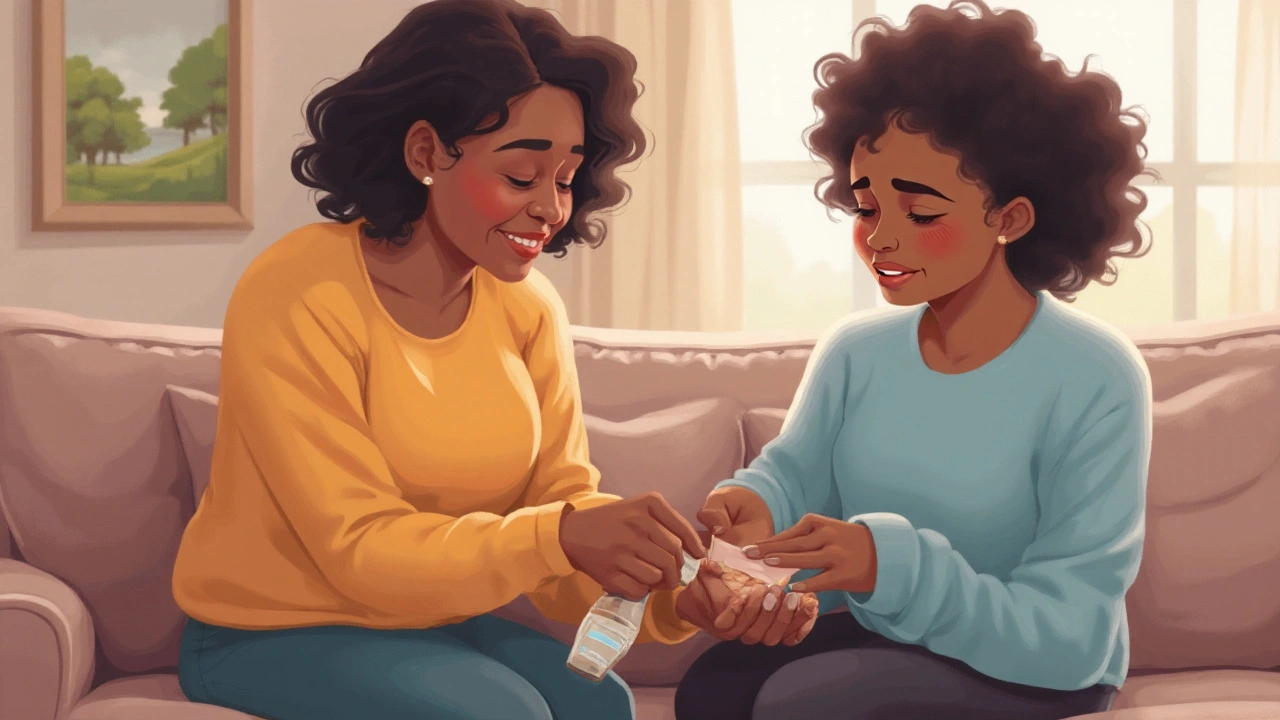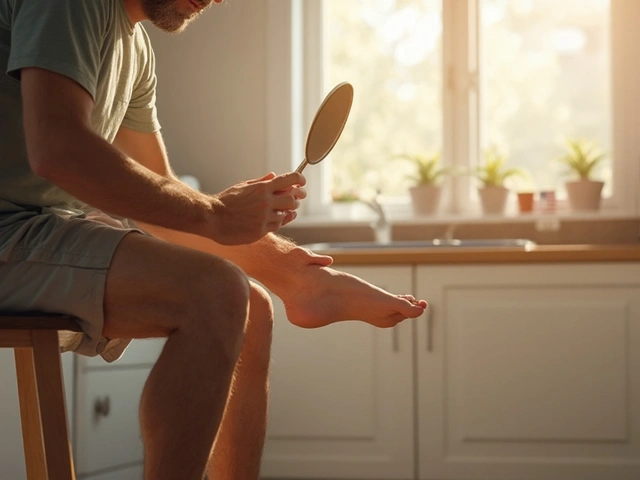Quick Take
- Look for redness, swelling, or any break in the skin on the foot.
- Check daily, especially after a long walk or injury.
- If a sore is >0.5 cm, painful, or shows discharge, see a podiatrist.
- Home care: clean, protect, and off‑load pressure.
- Long‑term: control blood sugar, wear proper shoes, and schedule regular foot exams.
diabetic foot sore is a skin breakdown on the foot that occurs in people with diabetes, often due to nerve damage and poor circulation. It’s more than an inconvenience; left untreated it can lead to infection, amputation, or even death. The good news? Most sores can be caught early and managed with simple steps. Below is a hands‑on roadmap that walks you through spotting, caring for, and preventing these wounds.
What Triggers a Diabetic Foot Sore?
Two core problems create the perfect storm:
- Peripheral neuropathy is a nerve disorder that dulls sensation in the feet, so minor cuts or pressure go unnoticed.
- Peripheral arterial disease is a circulatory condition that restricts blood flow, slowing healing and increasing ulcer risk.
Combine these with high blood glucose, and the skin becomes fragile, sweat glands shrink, and the foot’s natural defense crumbles.
Early Warning Signs You Can’t Afford to Miss
Because the nerves are muted, visual checks are key. Scan every toe, heel, and the spaces between the toes at least once a day. Look for:
- Redness that doesn’t fade after a few minutes.
- Any blister, scab, or raw area, no matter how small.
- Swelling or a feeling of tightness.
- Unusual odor, which hints at infection.
- Discoloration-black or brown patches may signal tissue death.
If any of these appear, jot down the size (use a ruler) and take a clear photo. Documentation helps clinicians track progress.
When to Call a Professional
Home care works for tiny, clean lesions, but you need expert help if:
- The sore is larger than 0.5cm (about the size of a pea).
- There’s pus, foul smell, or a yellow‑white crust.
- Pain spikes despite off‑loading.
- Redness spreads beyond the wound’s edge.
- Bleeding won’t stop after 10minutes of pressure.
These signs often indicate infection, deep tissue involvement, or inadequate blood flow-conditions that need a podiatrist, wound‑care nurse, or vascular surgeon.
First‑Aid Steps You Can Do Right Now
- Wash your hands. Use soap and warm water for at least 20 seconds.
- Gently rinse the wound with sterile saline or clean water. Avoid scrubbing.
- Pat dry with a sterile gauze pad-don’t rub.
- Apply a thin layer of a non‑adherent dressing (e.g., a silicone gauze) to keep the wound moist.
- Secure the dressing with a light, breathable bandage. Make sure it’s snug but not tight.
- Elevate the foot above heart level for 15‑20 minutes to reduce swelling.
- Off‑load pressure: use a specialized shoe, a cushioned sandal, or a wheelchair if standing is painful.
Repeat the cleaning and dressing change at least once daily, or more if the dressing becomes wet or dirty.
Professional Care: What to Expect
When you see a wound‑care specialist, they’ll assess three pillars: Debridement is a procedure that removes dead tissue to promote healthy granulation. Off‑loading devices are custom orthotics or total‑contact casts that redistribute pressure away from the ulcer. and Wound dressings are specialized dressings chosen for the ulcer’s depth, exudate level, and infection status.
Typical steps include:
- Measuring the ulcer using the Wagner or University of Texas classification system.
- Testing blood flow with an Ankle‑Brachial Index (ABI) or toe pressure.
- Taking a culture if infection is suspected.
- Prescribing antibiotics tailored to the cultured bacteria.
- Implementing a dressing regimen that changes based on exudate volume.

Choosing the Right Wound Dressing
| Dressings | Ideal For | Absorption | Key Benefit |
|---|---|---|---|
| Hydrogel | Dry or minimally exudating wounds | Low | Provides moisture to stimulate granulation |
| Alginate | Moderately to heavily exudating ulcers | High | Forms a gel that locks in bacteria‑free environment |
| Foam | Variable exudate, vulnerable to maceration | Medium‑High | Protects surrounding skin while absorbing fluid |
| Charcoal‑impregnated | Infected or malodorous wounds | Medium | Adsorbs toxins and reduces odor |
Choosing the right type hinges on the ulcer’s moisture level and infection status. Your clinician will switch dressings as the wound evolves.
Off‑Loading: Relieving Pressure for Healing
The best‑selling research shows that consistent off‑loading cuts healing time in half. Options include:
- Total‑contact cast (TCC) is a custom‑molded cast that evenly distributes weight across the entire foot and lower leg. - Gold standard for plantar ulcers.
- Removable cast walkers - Easier to inspect but rely on patient compliance.
- Custom orthotic shoes - Good for minor pressure points and daily wear.
- Heel lifts - Simple devices to reduce tension on the Achilles tendon.
Even a small shift in pressure can prevent a tiny blister from becoming a deep ulcer.
Long‑Term Prevention Strategies
Managing the underlying causes is just as crucial as treating the wound itself.
- Glycemic control is a continuous effort to keep blood sugar within target ranges (70‑130mg/dL fasting). Use insulin, oral meds, and diet to stay on target; each 1% drop in HbA1c reduces ulcer risk by ~30%.
- Daily foot inspection - Use a mirror or ask a partner for help.
- Proper footwear - Look for shoes with a wide toe box, cushioned sole, and breathable material.
- Regular podiatry visits - At least twice a year, or quarterly if you’ve had an ulcer before.
- Quit smoking - Nicotine constricts vessels and worsens peripheral arterial disease.
Related Conditions You Should Know About
Understanding the broader health picture helps you anticipate problems.
- Charcot foot is a severe neuropathic joint destruction that can mimic a foot ulcer but requires immobilization.
- Renal insufficiency - Reduces the body’s ability to clear infection.
- Obesity - Adds extra pressure on the forefoot, accelerating callus formation.
Discuss these risks with your endocrinologist; a coordinated care plan tackles multiple fronts.
Next Steps After Healing
Even when the ulcer closes, vigilance can’t drop.
- Maintain a wound‑care diary for the next 6months.
- Schedule a follow‑up podiatry visit at 2‑week intervals until the skin fully remodels.
- Re‑evaluate footwear; consider custom insoles if pressure points reappear.
- Continue strict blood‑sugar monitoring; target A1c <7% if possible.
Consistency is the secret weapon against recurrence.
Frequently Asked Questions
How quickly can a diabetic foot sore become infected?
Infections can set in within 24‑48hours, especially if the ulcer is deep, exudating, or located on the plantar surface where pressure is high. Prompt cleaning and off‑loading are essential to keep bacteria at bay.
What is the best dressing for a heavily draining ulcer?
Alginate dressings excel at absorbing large volumes of fluid while forming a gel that maintains a moist environment. They also conform to irregular wound beds, making them a top choice for heavily exuding diabetic foot ulcers.
Can I use over‑the‑counter antibiotic ointment on a foot sore?
OTC ointments like bacitracin may mask infection signs and delay proper treatment. If a sore shows any sign of infection-redness, warmth, pus-seek professional care for culture‑directed antibiotics.
How often should I replace my diabetic footwear?
Every six months, or sooner if you notice wear on the sole, loss of cushioning, or any new pressure points. Regular inspection ensures the shoe continues to off‑load correctly.
Is a total‑contact cast necessary for all foot ulcers?
TCC is the gold standard for plantar ulcers because it eliminates pressure entirely. However, for shallow or non‑plantar lesions, removable walkers or custom orthotics may provide sufficient off‑loading while allowing wound inspection.
What blood‑sugar level minimizes foot‑ulcer risk?
Studies show an A1c below 7% cuts the incidence of foot ulcers by roughly one‑third. Individual targets may vary; consult your endocrinologist for personalized goals.
Can I walk with a diabetic foot sore?
Only if the ulcer is tiny, clean, and fully off‑loaded. Otherwise, walking adds shear forces that deepen the wound and heighten infection risk. Use a wheelchair or crutches until the wound is properly dressed and pressure‑free.


Wow, what a comprehensive guide! The way you break down the steps, from daily inspection to off‑loading, is just brilliant, and the use of tables makes the dressing choices crystal clear,; you really covered the bases,; keep spreading this gold‑standard info,; thanks a ton!
This is basic foot care, nothing fancy.
The recommendations align with current wound‑care protocols; however, adding a note on the frequency of ABI testing would enhance completeness. :)
OMG this article saved my life!!! I was like, "my foot is hurting sooo bad" and I didn't know what to do. Thank u sooo much!! Seriously, this is lifesavrrr. But rly, some of the tech terms are kinda confusing.
I have to say, reading this guide felt like getting a masterclass in diabetic foot care, the author not only lists the warning signs but also explains why they happen, which is crucial for anyone who struggles to understand the underlying physiology, the emphasis on daily self‑inspection cannot be overstated, because catching a tiny blister before it becomes a deep ulcer can literally save a limb, the step‑by‑step first‑aid instructions are spot on, washing hands, using sterile saline, and keeping the dressing moist are all evidence‑based practices, I also love the detailed table comparing dressings, it makes choosing the right product less intimidating for patients and clinicians alike, the discussion on off‑loading options, from total‑contact casts to custom shoes, provides a realistic spectrum of solutions, especially noting that patient compliance is a major factor when opting for removable walkers, the guide wisely reminds readers to monitor blood sugar closely, since every 1% drop in HbA1c can reduce ulcer risk dramatically, and the reminder to quit smoking ties vascular health back into the care plan, all of this is wrapped up with clear follow‑up steps, like maintaining a wound‑care diary and scheduling regular podiatry visits, overall, this is a stellar resource that could be printed and given to every diabetic patient, and I would highly recommend it to both patients and healthcare providers alike.
The cultural shift toward proactive foot care is evident; this guide is a catalyst for that change.
good info thanks
Great guide! Keep sharing these tips, they help a lot.
The ontological implications of self‑care, as elucidated herein, underscore the interdependence of bodily integrity and moral responsibility. By adhering to the prescribed regimen, one not only preserves physical health but also affirms a commitment to the ethical stewardship of one’s own being. Consequently, this discourse transcends mere medical instruction and enters the realm of philosophical praxis.
Did they forget to mention how big pharma pushes expensive dressings while cheap options work just fine? Something smells off.
While the article is comprehensive, it neglects the importance of regular podiatrist‑led debridement; such oversight could compromise healing outcomes.
Our nation needs to adopt these practices now.
Interesting read, but a bit fluffy.
Absolutely, the guide’s clarity makes it accessible to anyone, and the step‑by‑step approach really empowers patients.
Indeed, the integration of evidence‑based protocols with patient‑centric education epitomizes best‑practice wound management, facilitating both compliance and optimal granulation tissue formation.
Even with its thoroughness, the guide could elaborate on the cost‑effectiveness of each dressing type, which is a critical factor in real‑world settings.
Good point about ABI frequency.
What a fantastic compilation! I’ll definitely share this with my support group – everyone deserves this level of detail to keep their feet healthy.
While you praise the guide, one must consider that many of these recommendations are generic and ignore individual variability!!!